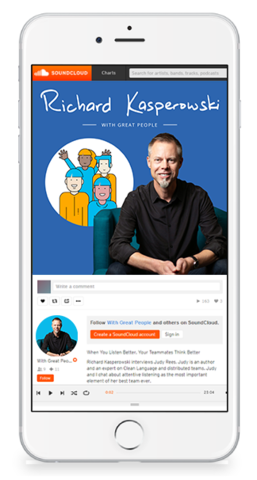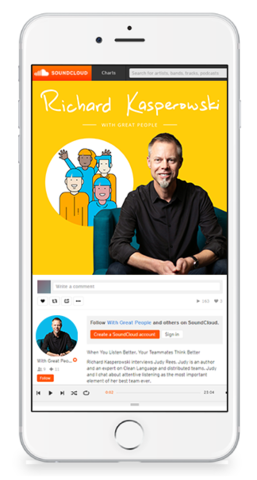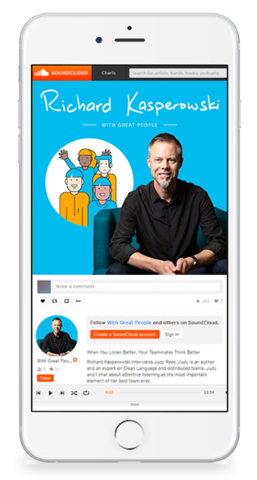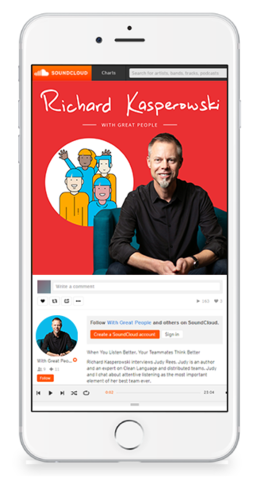Categories
Sally Elatta: Here Are 5 Factors That Will Guarantee Your Team’s High Performance
In this episode, Richard interviews Sally Elatta, CEO and founder of AgilityHealth. Sally tells us how leadership is just another way of serving a team and how leading from a place of love keeps the team engaged and focused. She also shares with us the top 5 predictors of a team’s high performance.
When you finish listening to the episode, connect with Sally on LinkedIn and visit agilityhealthradar.com.
Watch video

Listen Audio
Sally Elatta: Here Are 5 Factors That Will Guarantee Your Team’s High Performance
with Sally Elatta

TRANSCRIPT
Richard:
Hi, friends and welcome back to “With Great People,” the podcast for high-performance teams. I’m Richard Kasperowski. Our special guest today is Sally Elatta. Sally is the CEO and founder of Agility Health. To support this podcast, visit my website, kasperowski.com.
Richard:
Hello, Sally, how are you?
Sally:
Hello, Richard, I’m great. Thank you so much. I’m excited to be on your podcast.
Richard:
I’m so happy to have you here. Thanks for joining us. What else could you add on to that entry? There’s a lot more to Sally, a lot other than CEO and founder of Agility Health. What else?
Sally:
Sally is originally from Sudan in Africa. Sally has started a nonprofit organization on the side ’cause I have so much time, but my nonprofit is to support Sudan’s current revolution to democracy. Sally has three children. I have beautiful Yara, she’s 16; Cherise and Nora are 12 and 11, and I’m a belly dancer.
Richard:
Wow.
Sally:
There you go.
Richard:
All right.
Sally:
I love belly dancing.
Richard:
So much fun. All right, so…
Sally:
You’ve never had that in your podcast before. There you go, that’s your first.
Richard:
Nobody. Wow. We’ll have to, like… This is going to be great for the social media marketing. See video of belly dancer. No.
Sally:
No, no, don’t do that. Don’t do that.
Richard:
CEO, founder, and belly dancer.
Sally:
Nope. Nope. We’re not going to go there.
Richard:
No, but it’s always fun to learn a little bit about what people are doing outside of work, right? We all kind of have this mask on in front of us and this is our professional self, and whatever it says on the LinkedIn profile. And then there’s the other part of us, with the three kids and everything else, yeah.
Sally:
Nonprofit and trying to change the world. Yes.
Richard:
Yeah. Let’s see. So this podcast is about teams. And I know you do a lot of research about organizations and teams within organizations and that’s what Agility Health is all about. And I like to ask people about their best team ever. So your best team, if you could pick any team at any time in your life, and by team what I mean is any group of two or more people aligned with shared goals, which one of those groups of two or more people aligned with shared goals is the best one you’ve ever been a member of in your life?
Sally:
Well, I’m very biased. I’m going to say my current team that I have is awesome; they’re rock stars and I’ll tell you why. And I think that they’re fully engaged. They really care deeply about the purpose and the mission of the company. They really have pride of working here and serving our customers. They’re customer-focused, very customer driven. They continuously improve, which is what we do for business, right? We help everybody else. How do you measure and continuously improve? And I would say my team is always changing and they’re very open to feedback and they’re very humble and they’re willing to change. They don’t take it personally and change is hard. You know, change is difficult. So when you realize, okay, we’re not perfect, what can we do to improve? And you’re willing to inspect and adapt, I think that makes you awesome. And of course, they’re high performing, they deliver value that meets our customers expectations or even exceeds it. So that’s kind of the summary of my awesome team. It’s a lot.
Richard:
And you’re such a good public speaker. You didn’t just say this team, you gave me all the info about it and it’s almost like, okay, we’re done. Thanks for the conversation. But no, we’re not. We’re not done.
Sally:
No, there’s so much more. I mean, I was going to go into, there’s a wonderful book called “The Ideal Team Player” that talks about humble, hungry, and smart. And humble, hungry and smart… There’s a book by Patrick Lencioni, that’s kind of part of our hiring. We look for people that are humble, really, truly servant leaders and are, like I said, are okay with feedback and all that; hungry means that they’re very motivated, driven, they’re not waiting to be told what to do next; and then smart is really about emotional intelligence, so those are other attributes that are super important to us.
Richard:
Yeah, totally. And you have this team we’re talking about, this is the team at Agility Health. It’s a pretty tight-knit team.
Sally:
Yes.
Richard:
If you could summarize the sensation within you of being with that team, doing the work you do together, what’s the one word that you would use to summarize your team right now?
Sally:
I was going to say energized, they’ve always energized me, but I’m really going to be honest and say I’m grateful.
Richard: Grateful?
Sally:
Just grateful to have them. Yeah, I’m always grateful. Like, how lucky am I to be surrounded by such amazing people? How lucky am I to have such talent? So, just gratitude is what fills me when I see what they do.
Richard:
That is so cool. I think that that’s my first grateful and gratitude, which is really totally aligned with what you just said about humble, right? That you said humble, you said servant leader. It’s not just what you’re looking for when you’re hiring people, it kind of sounds like what you are.
Sally:
I try to be, yeah. And I think servant leadership is something I teach, I talk about all the time. But none of us are just built to be servant leaders. I think it’s something we easily, when times are tough, you can move back into a little bit of directive style and commanding and controlling. So I think it’s something we all aspire to be and you always have to pause, and for me, I lead from a place of love, Richard. If you know anything about me, I have a very big heart for people. So when I reach back into that, then I truly show up as a servant leader. When you reach into your place of driving for performance and driving for tasks being done, then you’re automatically moving a little bit back into your command and control, so I naturally have a very big heart and I lead from a place of love. And I think that’s where serving people, making sure their well-being… I just gave everybody Friday off just to make sure they had a longer weekend because I deeply care; I really genuinely care about them.
Richard:
All right. So there’s one example of leading with love. What else about leading with love?
Sally:
Wow. Leading with love. I roll a whole seminar, or a talk out there, but you really treat people with respect, with compassion. You value what they bring to the table. You figure out what do I need to do to help them grow? You give them feedback from a place of love. So leading with love doesn’t mean that I’m always going to tell you everything you want to hear. Sometimes I’m going to tell you that you’re not meeting expectations in a specific area, but I’m doing that not to put you down, it’s from a place of love ’cause I really want you to grow and be successful. So to me, leading with love also means giving people clarity on their vision, making sure you’re setting them up for success in whatever role, listening to them, being empathetic about what they’re saying, taking what they tell you seriously, taking action on it. That’s all leading with love.
Richard:
All right. Thank you. Okay. What else about this team right now and how do you know that it’s such a great team? What else about this team, subjectively, do you notice, qualitatively, or the way it feels within you as you’re working together?
Sally:
Well, it’s not always… I mean, I’m going to tell you we go through ups and downs. So anybody that tells you they have a perfect team all the time- So I will tell you, actually right now, my team feels tired. You just said, “What do they feel like right now?” We feel tired and the reason for that is we just had our big customer summit and there was a lot that we were working on to achieve that goal and that mission. But how do I know it’s an awesome team? If you listen to the words of the customers about how they describe us, to me, that’s it right there. If your customers can tell you that you’re doing an awesome job, that you high quality, they care, that you bend over backwards for them, that you really genuinely are a really trusted partner, I’ve always said if anybody calls us a vendor, we should leave. We’re not a vendor. We are a trusted partner on the journey. And so, the people that are on the front lines working with the customers, that’s the impression I want the customer to have is that we deeply care about them. So I think, how do you know your team is awesome? Ask your customers.
Richard:
All right. All right. Yeah. So this gets into, objectively, how do you know it’s a great team? and one of these objective ways you know it’s great team is your customers tell you this team is awesome. Is there anything else, objective or empirical, something you could notice from the outside?
Sally:
They’re engaged, they’re always ideating, they’re very creative, they lift each other up. You know, we have a cultural wall. They’re always thinking about new ways to improve what they do. They’re performing, they’re outcome-aligned. They’re always saying “What’s the business value of what we’re doing?” They’re willing to challenge me and us as leaders. They don’t look at our title. I always say, “We’re all leaving our titles at the door.” They’re willing to talk openly and honestly. I mean, there’s so much more that goes into that, but these are just a few things.
Richard:
All right, one of the things you just said was a culture wall. What’s that?
Sally:
Oh yeah, we don’t have it anymore, but it’s in our hearts and it’s in our screens ’cause we don’t work in the office anymore, Richard. But in our permanent office that we had, we had this beautiful wall and I had asked everybody to brainstorm. Why do they work here? What makes them happy? What’s important for them? Those are kind of the three things, what’s important? And it’s almost like a team norm activity, but we brainstormed on a whole bunch of sticky notes and we consolidate and we finally came up with this culture wall and it has all of the phrases that makes us want to work at Agility Health. And so, when you’re having lunch or you’re walking by, it’s in the center of the room, so some of the things that are there is “We do what we say we’re going to do,” “We are servant leaders at heart,” “We strive to be above the line.” There’s a wonderful video that talks about above the line, below the line. It’s called “Location by Conscious Leadership.” I love that video so much that everybody’s onboarded to watch that video about being above the line versus below the line and how we interact. Another cultural norm is we plant seeds, we don’t plant weeds about each other. Planting weeds is negativity, you know, telling negative things, whether it’s about a person or about the company strategy. If you have something to say, you don’t have to plant weeds; you can tell us, you can tell everybody directly. So that’s another example of what’s on the culture wall.
Richard:
All right. Are there any other concrete behaviors that go into this team’s success?
Sally:
I think everything on that culture wall. The servant leaders at heart, the being humble, hungry, and smart. We’ve let people go, Richard, and some people haven’t fit our culture if they have too much ego. Ego is not pretty. When you always think you’re smarter than other people, when you’re better than other people. So that doesn’t help you survive. But hungry, which is always, what can I help with? How can I take this forward? How can I serve the customer? Hey team, where can I help you? Just being like that, that’s really helpful for us. And emotional intelligence I think is really important, like knowing how you’re coming across. The other thing that’s important on the culture wall I’m really going to talk about is positive energy. Just having positive energy. Some team members, they don’t realize it, but they’re in a negative space in their head and so the energy they bring to the room is a negative energy, so they bring people down or they accidentally plant weeds everywhere. They’re saying negative things; that is not constructive. So we try to find and continue to push people back to the positive energy. What’s possible, assume positive regard in other people. Those are really important.
Richard:
And how do you push people back to that?
Sally:
You have to remind them. I think some of us, it’s kind of like a weed garden. It’s like a garden that you don’t water. You know, if you don’t really take care of it, if you’re not always plucking the weeds, they just start to form. And I think after events, after conflicts, after big deliverables that were high pressure, I think the weed garden can begin to foster. So I think you have to be conscious it’s happening. You have to bring it into, as an example, we have town halls where we talk really openly and honestly about this stuff in our all-company town hall meetings, share a couple of videos that re-inspire people, and let teams have open, honest retrospectives. Like, real retrospectives where you bring up that elephant in the room if you need to and restate your team norms again.
Richard:
Mhm. I’m curious about your your town halls and your retrospectives. You’re the founder and leader of this company. How do you foster that kind of open communication, despite, or in addition to, being the leader, hypothetically, or perhaps the loudest voice, or people used to use this this acronym, the HIPPO, the highest paid person.
Sally:
Yeah. It’s tough because people that don’t know you personally and haven’t worked with me closely, might assume, “Oh she’s the CEO. It’s that scary figure that we shouldn’t talk to or shouldn’t say anything in front of her.” And that’s the opposite of me. I’m like, “No, man, we got to talk real. Like what’s going on? What are you afraid of? Let’s talk about this. I’m just another human being like you. Please forget about my title. Let’s just have a real conversation. Even give me feedback. Maybe I screwed up. Maybe I did something wrong. Maybe I said something a specific way that triggered somebody. I can apologize. I don’t have that kind of ego.” So I think being in a highly, forget about the paid position, but in a role that everybody could assume that is intimidating, it reduces psychological safety for people to be open and honest ’cause they’re afraid of consequences, even if it’s not justified fear. So I try to facilitate the conversation. I try to show humility myself. I try to make it open. I do let everybody in the company, we use FunRetro boards sometimes when I want them to provide feedback in an anonymous way. We were going through a really tough period during COVID and people had some very deep questions for me, like financially how are we doing? Blah, blah, and I really let them post those questions to me live in FunRetro so that I can answer them directly and they wouldn’t feel that we know who they are. So I think you just have to sort of try to walk the walk.
Richard:
All right. Now, in addition to all the advice you’ve already shared, all the ideas shared, some of your concrete practices, what other advice do you have for listeners?
Sally:
Well, we just recently published a report around team performance, high performing teams, and I think just to give them another more practical, I would really love for them to download this report because we looked across 46,000 team members, which is about 4,600 teams in Agility Health. And we looked at the higher performing teams, what made them higher performing? Our next report’s going to be around happiness and roles and talent ’cause I’m focused on that too next. But everybody wants to know how can I get high performing teams? So in that report, whether it’s predictability, we want to improve predictability or time to market or value or quality or responsiveness, those are the five things we really zoomed in, here are the competencies that are drivers and predictors for that. And I’ll just give you a teaser of some of them because some people might want to hear them now. Working in in short iterations is a predictor of high performance, which we all knew that from an agile perspective. Planning and estimating, improving how you break down things into smaller chunks. But the next three, I was really surprised by. Generalizing specialists and T-shape individuals, so having people that are allowed to work and be skilled in other areas and not just focus on one thing. Self-organization, empowering teams to make their own decisions and telling them what the problem is but letting them kind of improvise on the how. And then the last one was creativity and innovation. So I was surprised by the last three ’cause they’re all about empowerment. And the first two were very much agile practices that we all know are pretty solid. But those five, in addition to a few others, were top predictors of team performance. The teams that were very strong were 37% higher performing, quantitatively, than teams that did not invest in these areas.
Richard:
All right. And you were gauging performance again by which of the metrics?
Sally:
Quality, predictability, time to market, value, and responsiveness, and all of the metrics were quantitative metrics. So when we say predictability, what percent of what the teams say they’re going to get done, they actually get done. When we say time to market, how frequently do they release to production? So it was very quantitative. A lot of the same metrics that are used in the DevOps world. The mean time to recover, deployment time, all those things.
Richard:
So really, really empirical, observable stuff that somebody outside the teams or the organization could actually see and measure. Yeah.
Sally:
Yes. Yep. Most of our radar, our team health radar, is qualitative metrics, but the performance metrics have now become quantitative. And so, that’s why we ran this report, ’cause we had enough data now over the last three, four years, we’re like we should figure out the correlation here. What is impacting what?
Richard:
Mhm. Oh and where can people find the report?
Sally:
Right on our website, agilityhealthradar.com. So on our homepage at the very top, there’s the download the top predictors of team performance, so they can click on it, download it. You don’t even have to add any information; it’s available for free.
Richard:
All right, perfect. So we’ll make sure we have a link to that and probably even a QR code just popped up on the video somewhere, I don’t know. Is there anything else you want to add? Anything you’ve been working on? Anything you’ve been thinking about lately? Anything at all?
Sally:
No. I just am happy that you’re doing this, Richard. You’ve been in this world of high performing, too for such a long time, so congrats on your success and thank you for inviting me to talk to your audience. That’s very nice of you. Thank you
Richard:
Oh, it’s a pleasure. You’re welcome. Oh, and how could listeners and viewers get in touch with you if they wanted to?
Sally:
sally@agilityhealthradar.com or just go to our website, yeah.
Richard:
All right, Sally Elatta. Thank you so much for joining us today. It’s really been fun hanging out with you. We sort of crossed paths at the, for me it was the first physical space conference post-COVID lockdowns. It was really nice seeing you in physical space again. It’s really nice having you here. Thanks so much.
Sally:
Thank you very much for Richard. I hope we cross paths soon again.
Richard:
I hope so too. And remember dear listeners and viewers, to support this podcast to visit my website, kasperowski.com





